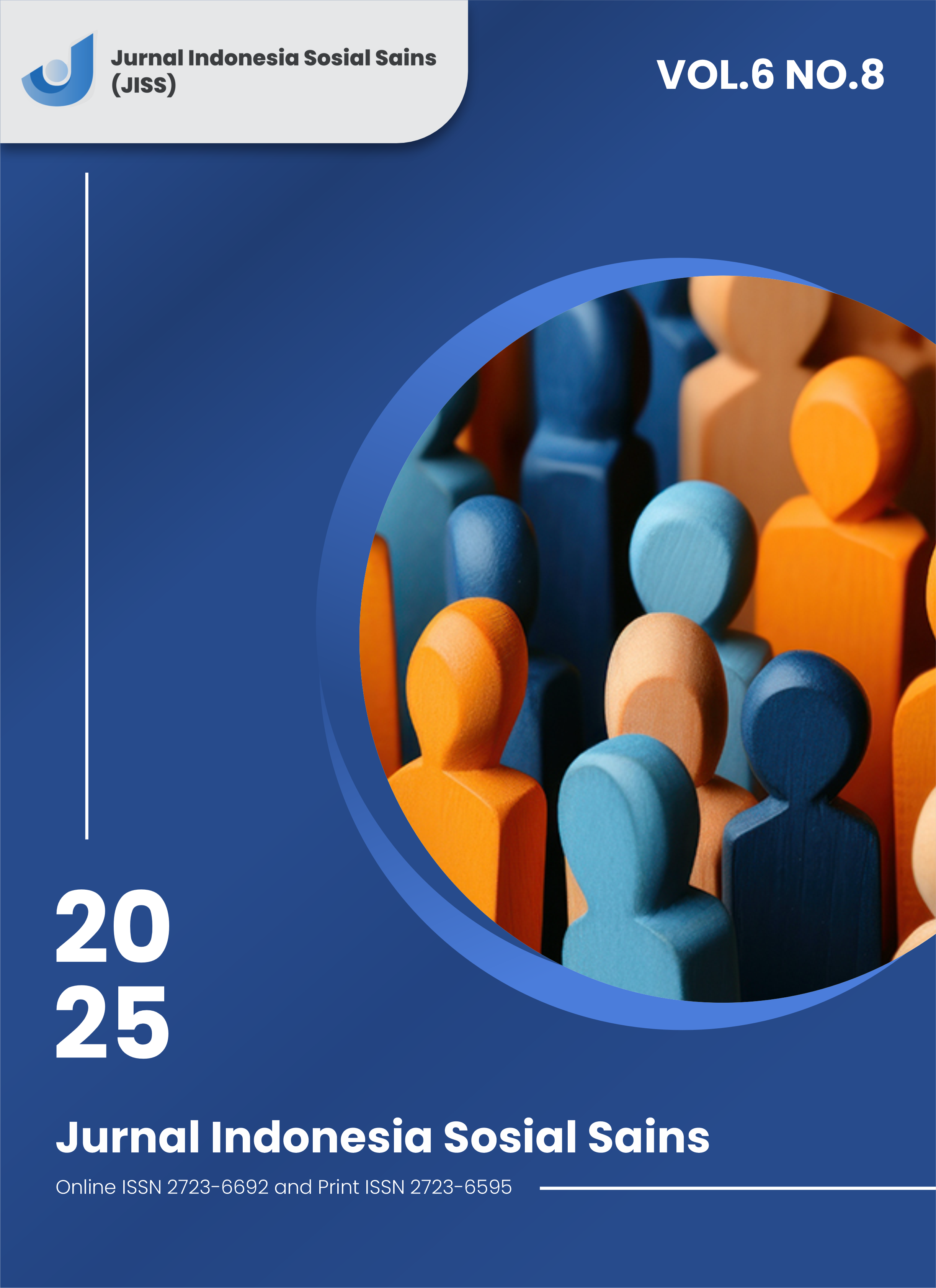The Effect of Bladder (BL) 32 Acupressure Point on Reducing Labor Pain Intensity During Active Phase of First Stage in Laboring Women
DOI:
https://doi.org/10.59141/jiss.v6i8.1840Keywords:
acupressure, active phase, bladder point BL 32, first stage of labor, Labor pain, pain management.Abstract
Labor pain is a physiological response experienced by mothers before the birth process. The level of pain felt can vary between mothers and may even differ in the same mother during each labor process. This study aims to determine the effect of Bladder (BL) 32 acupressure point on reducing labor pain intensity during the active phase of the first stage in laboring women in TPMB A area, Purwakarta Regency in 2024. This research used a quantitative approach with a pre-experimental design, specifically a one-group pretest-posttest design. The research sample consisted of 32 respondents assessed before and after the intervention. The sampling technique used was purposive sampling. The instrument used to measure pain was the Numeric Rating Scale (NRS). Data analysis was carried out using the Wilcoxon test. The results showed that labor pain intensity before the intervention had a mean of 7.28, while labor pain intensity after the intervention had a mean of 5.41, resulting in a mean reduction of 1.88. The p-value obtained was 0.000 (p<0.05). It can be concluded that there is a significant effect of the BL32 acupressure point on reducing labor pain intensity during the active phase of the first stage in laboring women in TPMB A area, Purwakarta Regency, in 2024. The implication of this research is that midwives should perform BL32 acupressure to reduce pain during labor.
References
Ahmar, H. (2021). Managemen Nyeri Persalinan Nonfarmakologis (Y. Umaya (ed.); I, Issue February). Ahlimedia Press.
Anggreni, D. (2022). Buku Ajar Metodologi Penelitian Kesehatan (E. D. Kartiningrum (ed.); I). STikes Majapahit.
Bonapace, J., Gagné, G.-P., Chaillet, N., Gagnon, R., Hébert, E., & Buckley, S. (2018). No. 355-physiologic basis of pain in labour and delivery: an evidence-based approach to its management. Journal of obstetrics and gynaecology Canada, 40(2), 227–245.
Harahap, D. A., & Harahap, S. A. (2022). Pengaruh teknik akupresur terhadap intensitas nyeri persalinan kala I fase aktif. Jurnal Kebidanan, 11(2), 145-152.
Hutabarat, V., Naibaho, N., Sitepu, S. A., Natalia, K., & Yanti, M. D. (2022). Pengaruh Teknik Pijat Akupresur Terhadap Penurunan Intensitas Nyeri Pada Kala I Fase Aktif Persalinan Di Puskesmas Korbafo Tahun 2022. Jurnal Penelitian Kebidanan & Kespro, 5(1), 10-15.
Katili, D. N. O., Potale, K., & Usman, S. (2018). Pengaruh Akupresure terhadap Penurunan Nyeri Persalinan Kala 1 Fase Aktif pada Primigravida di Ruang Bersalin Rsud Dr. M.M Dunda Limboto. Madu Jurnal Kesehatan, 7(1), 18-22.
Lilis, A., Dewi, S., & Sari, M. (2020). Efektivitas akupresur titik Sanyinjiao (SP6) terhadap nyeri persalinan kala I fase aktif. Jurnal Kesehatan Ibu dan Anak, 14(1), 25-31.
Mufidah, S., Kusumawardani, L. A., & Fadhilah, S. (2022). Acupressure Titik SP6, LI4 dan BL32 Mengurangi Nyeri Persalinan Kala I Systematic Literature Review. Jurnal MID-Z (Midwivery Zigot) Jurnal Ilmiah Kebidanan, 5(1), 29-40.
Mustafida, H., & Mukhoirotin. (2020). Pemberian Akupresur Kombinasi Titik BL32 dan LI4, Titik BL32 dan Sp6 Untuk Menurunkan Intensitas Nyeri Persalinan. Journal of Holistic Nursing Science, 7(2), 133-141.
Nasution, R., & Suryani, E. (2024). Pengaruh akupresur titik BL32 terhadap nyeri persalinan pada primigravida. Indonesian Journal of Midwifery, 7(1), 45-52.
Olza, I., Uvnas-Moberg, K., Ekström-Bergström, A., Leahy-Warren, P., Karlsdottir, S. I., Nieuwenhuijze, M., Villarmea, S., Hadjigeorgiou, E., Kazmierczak, M., & Spyridou, A. (2020). Birth as a neuro-psycho-social event: An integrative model of maternal experiences and their relation to neurohormonal events during childbirth. Plos one, 15(7), e0230992.
Pratiwi, A. D., Sari, K., & Wulandari, P. (2021). Efektifitas akupresur dalam mengurangi nyeri persalinan: Systematic review. Jurnal Riset Kesehatan, 10(2), 78-85.
Puspa, Y. R. N., Sartika, T. D., & Handayani, S. (2022). Analisis Hubungan Usia, Paritas, Dan Kecemasan Dengan Intensitas Nyeri Persalinan Kala I Fase Aktif. Jurnal Ilmiah PANNMED, 17(2), 316-321.
Ramadani, Y., & Saputri, E. M. (2021). Asuhan pada Ibu Bersalin untuk Mengurangi Nyeri Persalinan dengan Teknik Akupresur. Jurnal Kebidanan Terkini, 1(2), 1-7.
Rezeki, S. (2020). Buku ajar Manajemen Nyeri Dalam Proses Persalinan (Non Farmakologi) (A. Yanto (ed.); II). Unimus Press.
Swarjana, I. K. (2016). Metodologi Penelitian Kesehatan. Penerbit Andi.
Vania, D. (2019). Akupresur pada titik BL 32 untuk manajemen nyeri persalinan kala I fase aktif. Jurnal Kebidanan Indonesia, 10(2), 89-95.
Downloads
Published
How to Cite
Issue
Section
License
Copyright (c) 2025 Daris Yolanda Sari

This work is licensed under a Creative Commons Attribution-ShareAlike 4.0 International License.
Authors who publish with this journal agree to the following terms:
- Authors retain copyright and grant the journal right of first publication with the work simultaneously licensed under a Creative Commons Attribution-ShareAlike 4.0 International. that allows others to share the work with an acknowledgement of the work's authorship and initial publication in this journal.
- Authors are able to enter into separate, additional contractual arrangements for the non-exclusive distribution of the journal's published version of the work (e.g., post it to an institutional repository or publish it in a book), with an acknowledgement of its initial publication in this journal.
- Authors are permitted and encouraged to post their work online (e.g., in institutional repositories or on their website) prior to and during the submission process, as it can lead to productive exchanges, as well as earlier and greater citation of published work.












